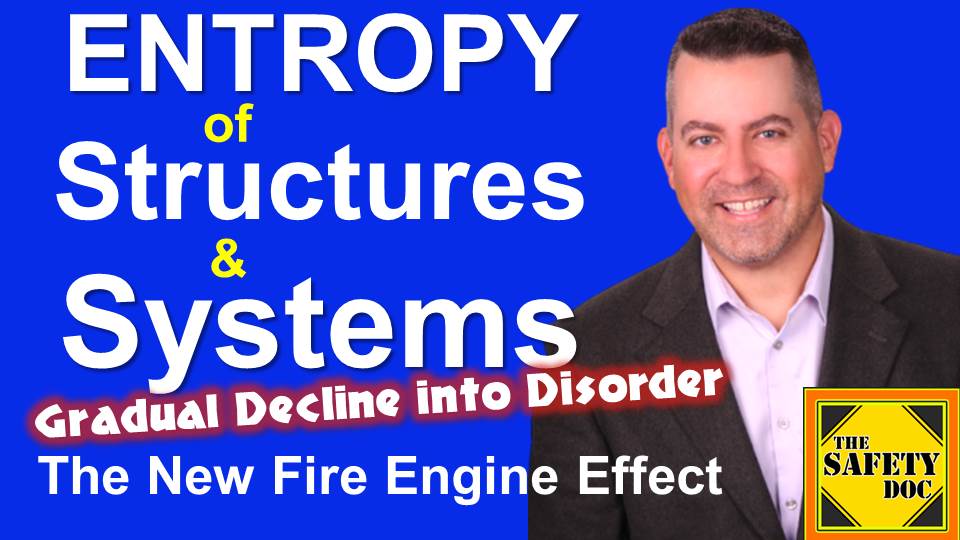Entropy of Structures and Systems | The New Fire Engine Effect | SDP159
[Podcast] Entropy is the gradual decline into disorder. An example of entropy is a melting ice cube. Water molecules are fixed and ordered in the cube. As it melts, the molecules become free to move and become independent and therefore become disordered. The second law of thermodynamics is that all things lead to entropy – from ice cubes to the human body. In this episode, Doc examines the entropy of structures and systems and centers these concepts on the example of a small village purchasing a replacement for its 30-year-old fire engine.

DIRECT LINK to MP3 of this Episode: https://tinyurl.com/SDP159-AUDIO
ENTROPY OF STRUCTURES. Over time, cars will rust, pavement will crack, and the human body will deteriorate. Although entropy of structures is a certainty, preventive measures and maintenance will slow the rate of entropy. For the car, it’s washing, waxing, and applying touch-up paint to new chips. Exercise staves off muscle atrophy. Even if all structures on Earth were immune from entropy, the sun would engulf the planet.
ENTROPY OF SYSTEMS. When the Texas power grid failed in the winter of 2017, a forensic analysis revealed a power grid system that had become old, outdated, and inefficient. Remember when you were in elementary school and participated in a monthly fire drill? The purpose of the drill was to ensure fidelity of the evacuation system. If you only practiced a fire drill the first week of the school year, then some students would forget the protocols as the year went on.
THE NEW FIRE ENGINE EFFECT. In October, 2021, the village board of a community of 1500 people in Wisconsin approved an expenditure for a new fire engine. At $400,000, the rescue pumper would be the costliest purchase in the village’s 2022 budget. The volunteer department’s fire chief was grilled by the city council members to justify the large expenditure. The prepared chief noted that the village’s primary engine, a 1990 pumper bought for $78,000, was well-maintained and also succumbing to entropy of structure and systems. In other words, the engine itself was demonstrating fatigue and it was difficult to find replacement parts for the aging apparatus. But there was something else. The outside world evolved 30 years beyond the world the engine entered. This is important. Let’s say that an exact new replica of the 1990 engine could be delivered to the fire station. Would that make sense? The firefighters would be familiar with the various levers and controls, right? Going back to the 1990 engine – it has a single cab and therefore only 3 firefighters can travel in it. Because of this limitation, the engine always needed a companion as the department always sent at least 4 firefighters to a call. This meant that two fire trucks were sent to accidents in order to have sufficient personnel – an accepted practice in 1990 – in fact, the firehouse was often emptied for most calls as the mindset was to bring as many assets to an incident as possible.
CONTEMPORARY INDUSTRY PROTOCOLS – Electric Cars & Mutual Aid. Today, the “industry” protocol is to send a single “rescue” engine specifically built to transport 4-5 crew and extrication gear. The stalwart 1990 engine had a 1000 GPM pump. New engines are outfitted with a 1500 GPM pump. The village’s fire rating fell over the years due to static pumping capacity as the once-tiny industrial park flourished with new businesses. And then there’s GPS, comms, LED lighting and improved designs so ladders can be stored on top of the apparatus and lowered with ease. So that was all on the structure entropy side of things. The next part was systems entropy. In 1990, nobody thought about extinguishing an electric vehicle. Firefighters today train differently than their 1990 counterparts. In 1990, that small town fire department’s most frequent cold weather calls were to extinguish chimney fires as people heated their homes with sappy woods. And, the system of individual fire departments battling any blaze was a thing in 1990. In that Wisconsin village, a massive fire on Main Street was tackled by the fire department and the neighboring rural town’s department. Today, such a fire would activate mutual aid from multiple communities. With the advent and acceptance of mutual aid, fire departments are streamlining their fleets and pool assets.
SCHOOL SAFETY. So what does this mean for school safety? As entropy happens slowly, it’s almost impossible for schools to detect it. Plus, there is frequent turnover of school staff – so these folks aren’t around long enough to observe entropy. What can a safety expert do for a school? Identify the state of entropy and make recommendations to restore structures or systems (to original), refurbish them (modernize them as possible), or replace them.
This is episode 159 of The Safety Doc Podcast published on 11-22-2021.
FOLLOW
- Watch this episode on “The Safety Doc” YouTube channel https://tinyurl.com/SDP159-VIDEO
- Listen to this episode on PodBean MP3 https://tinyurl.com/SDP159-AUDIO
- Apple Podcasts http://tinyurl.com/SafetyDocApplePodcasts
- SAFETY DOC WEBSITE & BLOG safetyphd.com
- Follow David & The Safety Doc Podcast on Twitter @SafetyPhD
- Email Dr. Perrodin thesafetydoc@gmail.com
Purchase Dr. Perrodin’s book: Schools of Errors – Rethinking School Safety in America
